Everything To Know About Cat6A Unshielded Direct Burial Ethernet Cable
Written by Don Schultz, trueCABLE Senior Technical Advisor, Fluke Networks Copper/Fiber CCTT, BICSI INST1, INSTC, INSTF Certified
Sometimes you find yourself running Ethernet cable outside. You might even need to bury Ethernet cable. The question of Category comes up quite a bit. Although Cat6 Ethernet cable is extremely versatile and can achieve 10 Gbps (10G) up to limited distances (depending on alien crosstalk conditions -- see When Aliens Attack! Avoiding Ethernet Alien Crosstalk), there are times the reliable and trusty Cat6 will not cut it. What if your remote structure is 200 feet away and you need to push 10G? What if your intention is to install 10G networking right now or in the immediate future? Considering we are talking about underground Ethernet cable, this is a good time to apply the “future proof” concept as well. Nobody wants to dig up gobs of perfectly good cable and replace it.
If any of these situations apply to you, you just signed up for Cat6A cable. Cat6A is the ultimate copper based Ethernet cable. Ignore Cat7 and Cat8--one is really snake oil and the other is meant for data centers that need 25G/40G up to 98 feet. A future blog will cover those Categories. Given you know you need Cat6A, you have to consider a number of factors such as cost and ease of installation. Much direct burial Cat6A cable is shielded and that means more expensive. Not all installations need shielded Ethernet cable (if you are wondering about that, please see Shielded vs. Unshielded Cable). It makes little sense to pay for shielded Ethernet cable (and more expensive shielded hardware) when unshielded will do the job. Unshielded direct burial Ethernet cable is also a lot easier to install correctly due to relaxed bend radii requirements and no need to bond to ground--neither factor is insignificant.
Make no mistake, even unshielded direct burial Cat6A Ethernet cable is thick and can pose installation challenges. My argument is why make this more difficult than it has to be?
Given all of the foregoing, I will be telling you all about trueCABLE’s Cat6A Direct Burial Unshielded Ethernet cable. This is a four part series:
- Overview blog and video talking about the cable specifically that will cover cable construction, correct termination hardware, environmental considerations, and installation best practices (this blog and video)
- 2nd blog and video on proper termination with unshielded Cat6A keystone jacks
- 3rd blog and video on proper termination with unshielded Cat6A field termination plugs
- 4th blog and video on proper termination with 8P8C (aka RJ45) modular plugs
I encourage you to read this entire blog and watch the video. Both formats bring their own benefits and clarity to give you the full picture.
Cat6A Performance and Length Limitations
Cat6A copper twisted pair Ethernet cable (regardless whether for indoors or outdoors) has a maximum application speed of 10Gbps (10G or 10GBASE-T) up to 295 feet in a permanent link configuration. Permanent links are the solid copper permanently installed portion of your cable system and always end up in female ports (keystone jacks, for example). The additional amount of cable to reach the 328 foot maximum you may have heard about is meant to be taken up by factory pre-made patch cords. That 295 foot number is predicated on ambient temperature. The 328 foot maximum for the entire channel (solid copper + patch cable) is further predicated upon patch cord conductor gauge--specifically the patch cords must be 24AWG stranded copper conductor and can be 16.5 feet on each side per the standard. If you use 26AWG or 28AWG patch cords at one or both ends your maximum 328 foot channel length must be “de-rated” which means shorter.
Can you run your Cat6A Ethernet cable to 328 feet and skip the patch cords for a direct connection? Technically, yes, and now you can reach 335 feet long officially, per ANSI/TIA 568.0-E. You would make use of Cat6A Field Termination Plugs at both ends. This particular piece of high performance termination hardware will be covered in our 3rd blog of the series. Hint: Do NOT use 8P8C (aka RJ45) modular plugs at both ends and expect to achieve 10G reliably! You have been warned. If you re-read the last sentence you just got warned twice.
So, I just dropped a lot of information on you. Here are some additional reference blogs for temperature and length de-rating:
- Temperature's Effect on Ethernet Cable Length
- Calculating Ethernet Cable Overall Channel Length for Success
Cat6A PoE Capability and Limitations
At this point you are likely wondering about PoE and if it affects your lengths or what kind of cable you can use. PoE means Power over Ethernet and is how many surveillance cameras, Wi-Fi access points, and other powered devices get their data AND power over the same cable. It is a very cool technology.
Assuming you are using pure solid copper Ethernet cable (not CCA or Copper Clad Aluminum) with a 22 to 24AWG diameter conductor wire you can be assured of full PoE compatibility. trueCABLE copper twisted pair Ethernet cables (Cat5e and above) all support 100W DC PoE, otherwise known as PoE++ Type 4 Class 8 or 802.3bt. You are not restricted on lengths assuming you obey the rest of the rules around ambient temperature, etc.
There is a “hidden” restriction, however. It comes in the form of the law, specifically the NEC/NFPA 70 (National Fire Protection Act). The limitation revolves around Ethernet cable carrying PoE that is bundled together or especially bundled together and placed inside conduit. What are those limitations? Here you go!
Table: Maximum PoE Cable Bundle Size with Multiple Variables
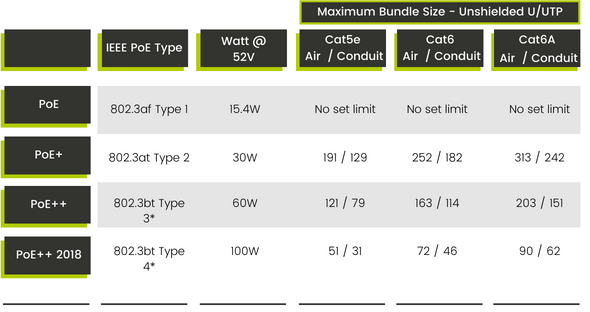
* Type 3 and Type 4 are also known as PPoE or 4 Pair PoE. Type 2 PoE is for 2 Pair PoE.
Notes for using this table:
- If using shielded Ethernet (F/UTP foil overall shield) then the cable counts above may be safely increased by 10% as the shielding allows for better heat dissipation
- Bundles of mixed Category cables carrying PoE should be rated with the worst scenario in mind (for example, if you have Cat5e and Cat6 in the same cable bundle then use the figures for Cat5e)
- Cat5e conductor gauge is assumed to be 24AWG
- Cat6 and Cat6A conductor gauge is assumed to be 23AWG
- All figures are for solid copper conductors
- Ambient temperature is assumed to not exceed 113°F or 45°C
- This table is constructed to avoid a temperature rise exceeding 27°F or 15°C above ambient so as to not exceed cable operating temperature
So, if your cables that carry PoE are unbundled you need not worry about this above table. If your cables carry PoE and are bundled you are restricted depending on how you install them and what DC wattage they carry. Fortunately we have a table for that!
If you want a detailed read around PoE Installation Best Practices involving Ethernet then click the link above. The chart above will be in there, along with a lot more information.
Correct Installation Environment and Obeying the Law
We are going to talk about the law again. The NEC (National Electrical Code) which is part of the NFPA (National Fire Protection Act) has a lot to say about cable sheaths. Cable sheaths mean cable jackets. Generally, the NEC separates cable jackets suitable for indoor installations and ones suitable for outdoor installations (called OSP or Outside Plant cable). CMX jackets are considered OSP for legal and safety reasons. LLDPE, or Linear Low Density Polyethylene is wonderful for preventing UV damage and water intrusion. It is, however, also very good at helping to spread a fire inside a structure given the wrong circumstances. trueCABLE Cat6A Unshielded Direct Burial cable uses a LLDPE jacket.
There is an exception to the rules which allow OSP cables to be used inside residential structures as long as the cable does not exceed 0.25” in diameter. Our Cat6A Unshielded Direct Burial cable exceeds 0.25” in diameter, so it does not meet the exception. Therefore, the blanket commercial rules apply to installation. What rules are those?
- Your OSP cable may come into your structure up to a maximum of 50 feet before you must transition it to indoor cable or terminate it
- You may go past the 50 foot number IF the cable is placed inside a medium weight steel conduit (IMC), threaded, and the joints must be sealed
It is unlikely residential installers will need to worry about going past 50 feet inside their home. Commercial installers, however, will need to pay extra attention.
Direct Burial and Other Installation Considerations
If the process of direct burial intimidates you, then you are not alone. I strongly recommend you read Into the Great Outdoors: Running Ethernet Cable Outside. Direct burial Ethernet cable can be used above or below ground. If below ground, it may be directly buried or placed into conduit.
Another factor is known as bend radius. Outdoor (and especially direct burial) Ethernet cable won’t bend nearly as easily and has additional restrictions around how tight you should bend it. Exceeding these restrictions will drastically shorten the lifespan of your cable, void your warranty, and pose potential data transmission problems. So, please use this guideline:
trueCABLE Cat6A Unshielded Direct Burial has a maximum bend radius (measured on the inside surfaces) of 3.50cm or 1.50 inches. If you visualize that as a circle, that is 7.00cm or 3.00 inches circumference.
Cable Construction and Technical Details
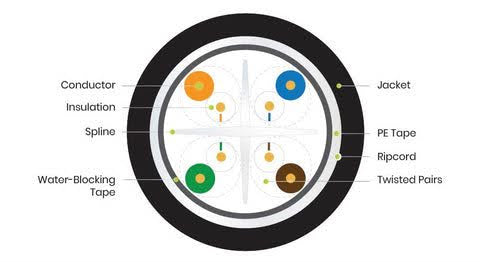
Technical Data:
- ANSI/TIA 568-2.D compliant and Permanent Link tested to Cat6A performance
- Unshielded (U/UTP)
- CMX rated LLDPE outdoor jacket
- Water blocking tape for direct burial applications
- May be used above or below ground
- 23AWG solid pure copper conductors
- Supports PoE, PoE+, and PoE++ (IEEE 802.3af/at/bt) up to 100W
- 6.80mm cable jacket outer diameter (OD)
- 1.01mm insulated conductors
For more detail, please refer to the specification sheet.
Here are some pictures of the construction and interior details:
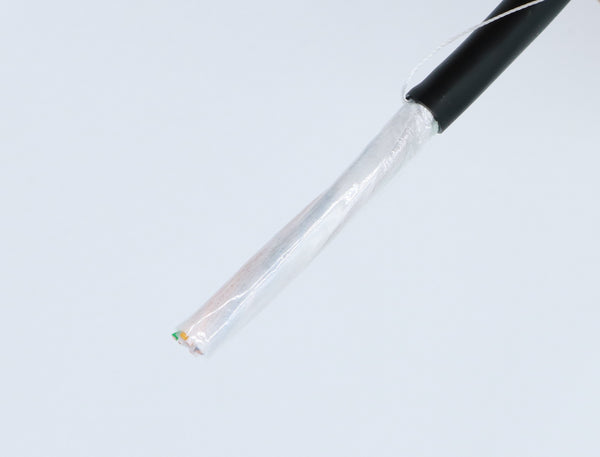
Cable stripped, showing PE tape and rip cord with water block tape underneath
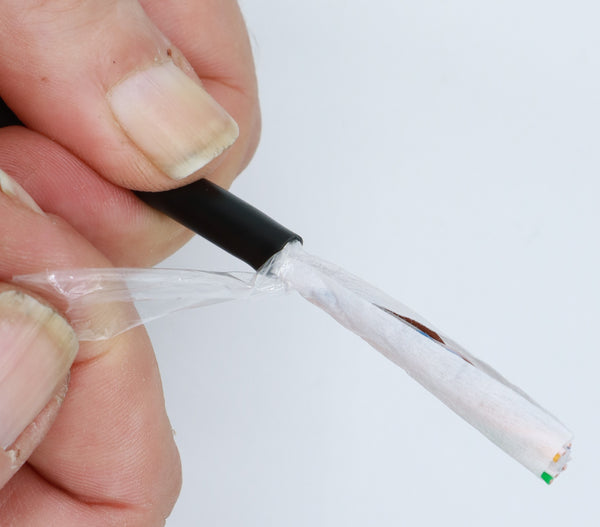
PE tape removed exposing water block tape
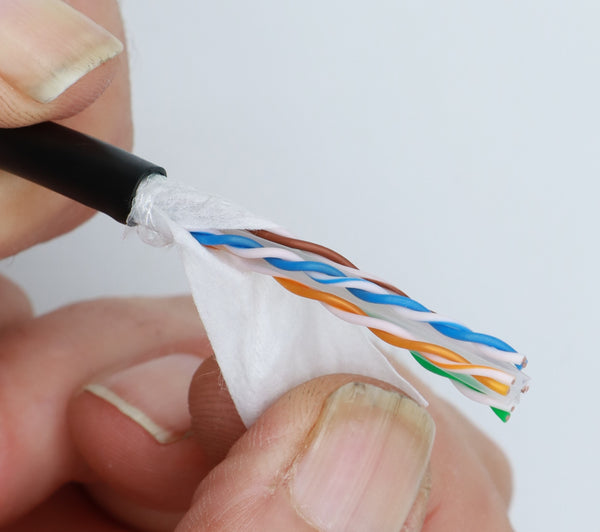
Water block tape peeled back exposing conductor pairs and spline
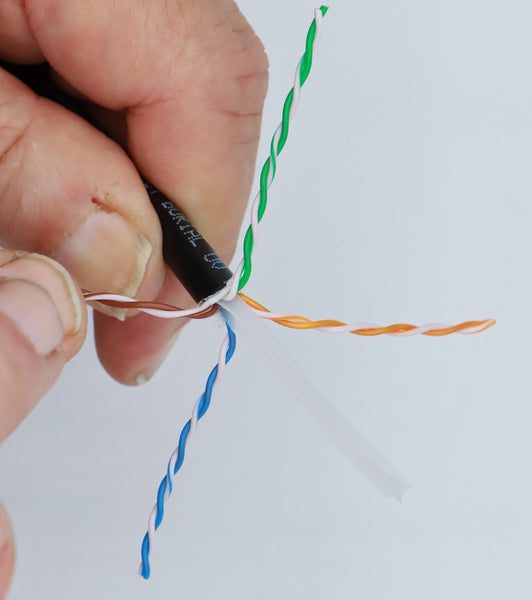
Tapes removed, exposing interior spline and conductor pairs
Common Questions & Answers
trueCABLE gets many questions about direct burial Ethernet cable. We have distilled the most common questions below with candid answers. Please be aware that the questions are literally as they were typed in by people searching on the Internet, so spelling and grammar may seem a bit…off. We want people to easily find the answers, so we post the questions unmodified or corrected.
Can Cat6a be buried?
Does Ethernet need to be in conduit?
How far can you bury Ethernet cable?
Can you run Cat 6 in same conduit as electrical?
Can I use PVC pipe for Ethernet cable?
Can Cat6a be unshielded?
Do you need to ground shielded Cat6?
So, that is the anatomy of our Cat6A Unshielded Direct Burial Ethernet. There is a bit more to it than Cat6A U/UTP Riser, for example, but all the extra stuff inside and tough exterior LLDPE CMX jacket give it the ability to perform at 10G right in the dirt!
HAPPY NETWORKING!
trueCABLE presents the information on our website, including the “Cable Academy” blog and live chat support, as a service to our customers and other visitors to our website subject to our website terms and conditions. While the information on this website is about data networking and electrical issues, it is not professional advice and any reliance on such material is at your own risk.






















































